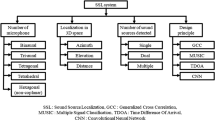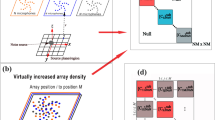Abstract
This paper shows the importance of the optimal smoothing scheme in Microphone Array Post-Filtering (MAPF) under a combined Deterministic-Stochastic Hybrid Model (DSHM). We reveal that some of the well-known MAPF algorithms may cause serious speech distortion without using the optimal smoothing scheme, which is resulted from oversmoothing the raw periodogram over time. Using a minimum conditional mean square error criterion, we derive the optimal smoothing factor under the DSHM, where the Deterministic-to-Stochastic-Ratio (DSR) and the stationarity determine the value of the optimal smoothing factor. The optimal smoothing scheme is applied to the Transient-Beam-to-Reference-Ratio (TBRR)-based MAPF algorithm and experimental results show its better performance in terms of both the Log-Spectral Distance (LSD) and the Perceptual Evaluation of Speech Quality (PESQ).
Similar content being viewed by others
References
J. Benesty, S. Makino, and J. Chen. Speech Enhancement. Berlin, Springer-Verlag, 2005, 9–134.
P. C. Loizou. Speech Enhancement: Thoery and Practice. Boca Raton, Florida, CRC, 2007, 97–462.
P. C. Loizou and G. Kim. Reasons why current speech-enhancement algorithms do not improve speech intelligibility and suggested solutions. IEEE Transactions on Audio, Speech, and Language Processing, 19(2011)1, 47–56.
M. Brandstein and D. Ward. Microphone Arrays: Signal Processing Techniques and Applications. Berlin, Springer-Verlag, 2001, 255–280.
J. Benesty, J. Chen, and Y. Huang. Microphone Array Signal Processing. Berlin, Springer-Verlag, 2008, 39–222.
C. Liu, B. C. Wheeler, W. D. O’Brien, et al. Localization of multiple sound sources with two microphones. Journal of Acoustics Society of America, 108(2000)4, 1888–1905.
G. Shi, P. Aarabi, and H. Jiang. Phase-based dual-microphone speech enhancement using a prior speech model. IEEE Transactions on Audio, Speech and Language Processing, 15(2007)1, 109–118.
I. A. McCowan and H. Bourland. Microphone array post-filtering based on noise field coherence. IEEE Transactions on Speech and Audio Processing, 11 (2003)6, 709–716.
C. Zheng, Y. Zhou, X. Hu, and X. Li. Two-channel post-filtering based on adaptive smoothing and noise properties. International Conference on Acoustics, Speech, and Signal Processing, Prague, Czech Republic, May 22–27, 2011, 1745–1748.
N. Yousefian, M. Rahmani, and A. Akabari. Power level difference as a criterion for speech enhancement. International Conference on Acoustics, Speech, and Signal Processing, Taipei, Apr. 19–24, 2009, 4653–4656.
I. Cohen. Mulitchannel post-filtering in nonstationary noise environments. IEEE Transactions on Signal Processing, 52(2004)5, 1149–1160.
A. Guerin, R. Le. Bouguin-Jeannes, and G. Faucon. A two-sensor noise reduction system: applications for hands-free car kit. European Association for Signal Processing Journal on Applied Signal Processing, 2003(2003)11, 1125–1134.
R. Martin. Noise power spectral density estimation based on optimal smoothing and minimum statistics. IEEE Transactions on Speech and Audio Processing, 9(2001)5, 504–512.
R. C. Hendriks, R. Heusdens, and J. Jensen. An MMSE estimator for speech enhancement under a combined stochastic-deterministic speech model. IEEE Transactions on Audio, Speech, and Language Processing, 15(2007) 2, 406–415.
S. Jo and C. D. Yoo. Speech enhancement based on the decomposition of speech into deterministic and stochastic components and psychacoustic model. International Conference on Acoustics, Speech, and Signal Processing, Honolulu, Havaii, USA, Apr. 15–20, 2007, 897–900.
N. L. Johnson, S. Kotz, and N. Balakrishnan. Continuous Univariate Distributions. 2nd edition. New York, John Wiely Sons, INC, 1995, Vol. 2, 435–436.
I. S. Grandshteyn and I. M. Ryzik. Table of Integrals Series and Products. Sixth edition. New York, Academic, 2000, 651–652.
Author information
Authors and Affiliations
Corresponding author
Additional information
Supported by the National Natural Science Foundation of China (No. 61072123).
Communication author: Zheng Chengshi, born in 1980, male, Assistant Professor.
About this article
Cite this article
Hu, X., Zheng, C. & Li, X. Optimal smoothing for microphone array post-filtering under a combined deterministic-stochastic hybrid model. J. Electron.(China) 28, 524–530 (2011). https://doi.org/10.1007/s11767-012-0778-y
Received:
Revised:
Published:
Issue Date:
DOI: https://doi.org/10.1007/s11767-012-0778-y




